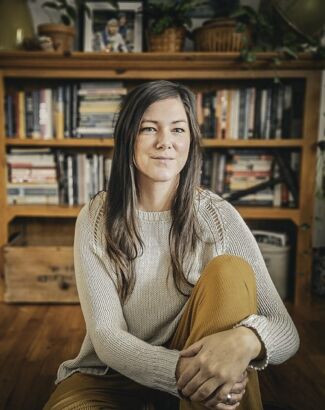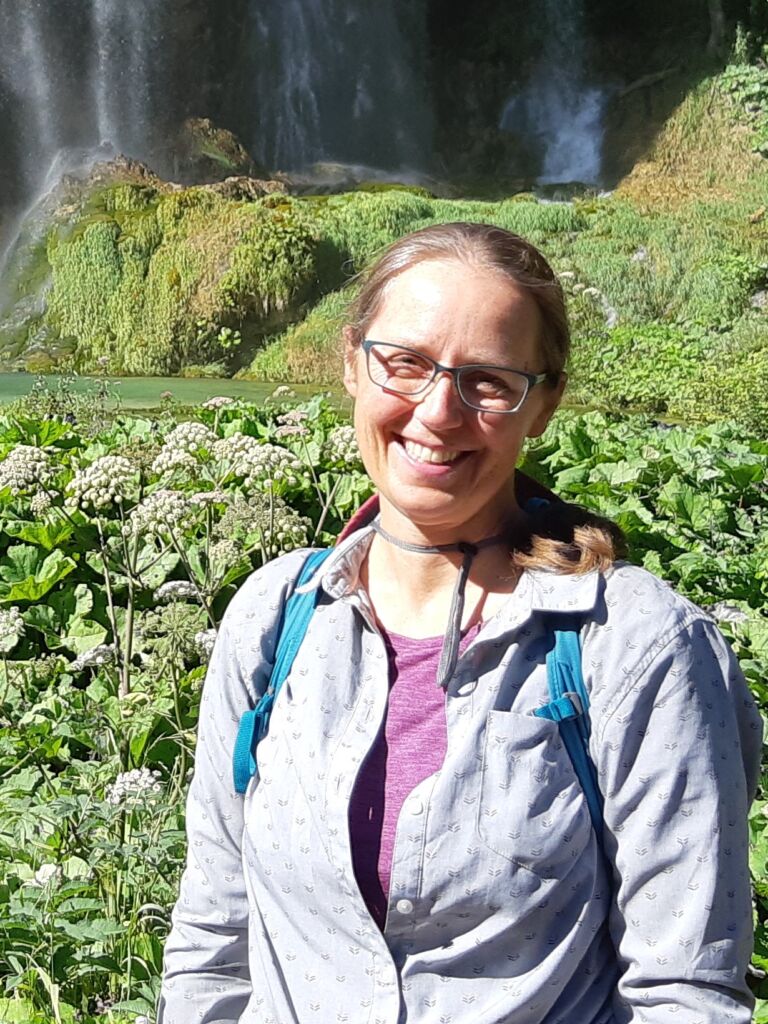Clothe local
Fleece and Fibre: Textile Producers of Vancouver Island and the Gulf Islands
by Francine McCabe
Victoria: Heritage House, 2023
$34.95 / 9781772034530
Reviewed By Sarah Thornton
*

Alisa Smith and J.B. MacKinnon published The 100 Mile Diet: A Year of Local Eating in 2007 and sparked a locavore resurgence, inspiring people to add more local foods to their diet. Some people grow their own food, while others seek out local products at farmers markets, making a connection with the people that grow their foods. Francine McCabe’s Fleece and Fibre: Textile Producers of Vancouver Island and the Gulf Islands seeks to inspire this same revolution and return to local living by introducing us to the people that grow the fibres used to make the clothing and textiles we need to shelter ourselves.
You don’t have to travel far from BC’s urban centres to experience the agricultural bounty that our mild climate allows. While most of BC’s population lives in the urban areas around Vancouver and Victoria, a rural lifestyle is embraced by many people, and agricultural products are an important economic driver. Vancouver Island (especially the southern and eastern regions) and the surrounding islands are home to many small farms, and government estimates show around 14,000 sheep in the region, along with many other fibre-bearing animals.

There is a strong textile history on Vancouver Island. Pre-European contact, the First Nations produced blankets using woolly dog and mountain goat fibres. European settlers brought sheep to the Islands in the 1800s and by the late 1800s sheep products – both meat and wool – were important contributors to the regional economy. The iconic Cowichan sweater was made from local wool by skilled Indigenous knitters. Up until not too long ago, there were carding mills and large looms (100”/2.5m wide) producing yardage. In recent years, however, high Vancouver Island land costs and changing labour environments have led to a reduction in local processing capacity resulting in increased costs as farmers now need to send their fibres off-Island for processing.
McCabe opens her book with a compelling essay which brings to light the damages caused by the current international textile economy, with its reliance on carbon-heavy shipping and cheap overseas labour, and pollution from petrochemical textiles which shed microplastics into the environment. She then offers an alternative, as described by Rebecca Burgess in her book Fibershed: Growing a Movement of Farmers, Fashion Activists, and Makers for a New Textile Economy and organization of the same name, whereby we move to using local fibres and dyes to produce textiles that will return to the soil at the end of their life. McCabe states that her goal with Fleece and Fibre is to “help bridge the gap between the farmers growing the product, the makers who produce the fibre into wearable, usable items, and consumers looking to support the local textile economy.”
If all you do is read the textile manifesto, you’ll come away with a lot to think about. But this book really shines in later sections, where McCabe brings us the stories of the people who work on the land and share relationships with their fibre, all combined with useful reference material. McCabe profiles twenty-one sheep breeds raised on over thirty farms, giving a brief description of the breed, its history in the region, and the fibre characteristics and suggested uses. Not all sheep are the same! The book’s beautiful photographs serve as a field guide; if you travel around the islands, you’ll start to notice the variation in the sheep in the fields, and this book can help you identify the breeds and understand their importance.

One breed is the North Country Cheviot, imported to Canada from the UK in the 1940s. The Canadian Department of Agriculture encouraged farmers to raise the hardy sheep, primarily for meat, but also for their good, though coarser, fibre. McCabe then shares the story of the Wytincks of Coneygeers Farm, near Nanaimo, who have farmed the land since the ‘80s, and have watched as roads have built up around the farm. The couple has a long history of involvement in sheep breeding and fibre work in the region.
Some farmers in the book are raising mixed breed flocks primarily for meat or dairy; the wool is a byproduct. Others are raising purebred sheep for their fibre and working to preserve the unique genetics of each breed. Many of the profiled farms offer raw fleeces for sale, while others have done value-added processing and have yarn, blankets, duvets, and dryer balls available.
The farms are varied, from old properties that have stayed in families for generations, to others that have only recently been established. Glen Alwin Farm was established in 1884 just north of Courtenay. Currently three generations of women run the property. Waste wool from their flock and others nearby is being processed into wool pellets, a valuable, all-natural garden amendment and fertilizer.
The Buchanans have operated Parry Bay Farm in Metchosin since the early ‘80s and are well-known providers of market lamb to area restaurants. In this section, McCabe describes watching shearing day at the farm, when Pieter DeMooy of Last Side Shearing worked to relieve the ewes of their heavy coats before lambing started in the spring.
One minor issue with the book makes it more difficult to use. The sheep section is organized alphabetically by breed, with farms listed and profiled after the breed description. Unfortunately, the publishers didn’t include an index, so it can be difficult to find a specific farm if you don’t yet know which breeds they raise!

McCabe also includes sections on farms raising other animals for fibre, including alpaca, llama, Angora rabbit, and goats (both cashmere and Angora). She describes her visit to Hinterland Farm on Pender Island and meeting with Hanahlie Biese and her young family, who raise alpacas and a small flock of purebred Bluefaced Leicester sheep. They have created a respected yarn line known by knitters and crocheters across Canada and the US by blending their own farm fibre with fibre from other farms across Canada.
Not all fibres come from animals – McCabe also describes plant-based fibres such as hemp and flax, both of which thrive in the climate of the region. She also includes a chapter on fibres from invasive species, such as English Ivy, morning glory, Himalayan blackberry, and yellow flag iris, and celebrates the people who work to restore natural ecosystems and transform waste materials into handmade textiles. I was inspired to see fibres that, while still requiring lots of processing labour, don’t require a lot of agricultural land to produce.
Fleece and Fibre is a detailed resource that I heartily recommend; I also happily display it on my coffee table, due to its beautiful photos and sumptuous paper quality. McCabe gives us insight into the lives of the people who have chosen to live a rural life in connection with their animals, people who care deeply for the land. She encourages us all to consider the root source of our clothing and textiles. Where do the raw materials come from? How are they processed? Who does that processing? Her book is a manifesto, presented in a beautiful, approachable manner.
*

Sarah Thornton is a connector – she loves bringing people and ideas together, especially over local fibres and foods. Originally from North Vancouver, her education and career in ocean sciences took her to both Alaska and Victoria. She now lives, works, and plays in the Comox Valley. She’s always found place an important part of her life – from hiking on the mountains and beaches, working in her garden, all the way to studying regional systems for meeting her family’s needs for foods and textiles. She’s a director with the Vancouver Island Fibreshed and writes for Digits & Threads on Canadian textile topics.
*
The British Columbia Review
Interim Editors, 2023-25: Trevor Marc Hughes (non-fiction), Brett Josef Grubisic (fiction and poetry)
Publisher: Richard Mackie
Formerly The Ormsby Review, The British Columbia Review is an online book review and journal service for BC writers and readers. The Advisory Board now consists of Jean Barman, Wade Davis, Robin Fisher, Barry Gough, Hugh Johnston, Kathy Mezei, Patricia Roy, Maria Tippett, and Graeme Wynn. Provincial Government Patron (since September 2018): Creative BC. Honorary Patron: Yosef Wosk. Scholarly Patron: SFU Graduate Liberal Studies. The British Columbia Review was founded in 2016 by Richard Mackie and Alan Twigg.
“Only connect.” – E.M. Forster